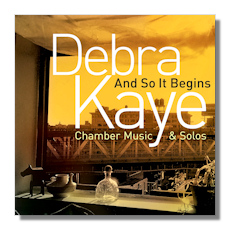
The Internet's Premier Classical Music Source
Related Links
- Latest Reviews
- More Reviews
-
By Composer
-
Collections
DVD & Blu-ray
Books
Concert Reviews
Articles/Interviews
Software
Audio
Search Amazon
Recommended Links
Site News
 CD Review
CD Review
Debra Kaye

And So It Begins
Chamber Music & Solos
- The Beauty Way for Treble, Tenor & Bass Viol
- Finding Accord for Violin, Cello & Piano
- Duet After Winter for 2 Violins
- Incidental Ducklings for Violin, Cello & Piano
- Dialogues With the Distant Mountains for Alto Sax & Piano
- Visions for Piano *
- The Doppelganger for Trombone
- And So It Begins for Tenor Sax, 2 Violins, Viola, Cello & Bass
Amy Kimball & Lynn Bechtold, violins
Entela Barci, viola
Arthur Cook & Garo Yellin, cellos
Frank Wagner, double bass
Marcia Eckert, piano
* Elizabeth Wolff, piano
Martha McGaughey, Jeanne Dorshe & Charlene Stobir, viols
Javier Oviedo, saxophones
Haim Avitsur, trombone
Charles Coleman, conductor
Recorded in 2013 at the American Academy of Arts and Letters, in New York
Ravello Recordings RR7899 71:43
Debra Kaye is a New York based composer, with degrees from Mannes College of Music and New York University. She is on the faculty of Mannes and has been executive director of the NY Composers Circle and President of the Howland Chamber Music Circle in Beacon, New York. She has awards from ASCAP, Meet the Composer, Mannes College, and the Edward T. Cone Foundation. This is her first recording, but her website lists performances and their venues from 2003, along with critical praise for many of them.
The eight selections on this disc – mostly short – are varied in style and instrumentation. They represent five commissions, some from the performers here. With a couple of exceptions, I find them increasingly appealing.
The title of the opening number, The Beauty Way, for what may be called a consort of viols, is a Navaho phrase, representing universal harmony. The nearly nine minute movement was inspired, Kaye says, by her residencies in Taos, and It incorporates Native American, African and Old English tunes. The music is varied, and includes short melodic phrases, with high bowed notes, some plucked strings, and a fluttery guitar-like passage. It opens and closes with harp-like sounds.
Finding Accord is a piano trio with some fragmentary flow as well as pointillistic effects, some ostinato and some tapping on wood. In a single movement, it runs 7:36. Kaye calls it a three-way conversation which "goes in and out of agreement in a tête-a-tête of musical opposites."
Duet After Winter, a nine minute piece for violin duo, quietly, but sometimes intensely, expresses yearning following news of a Japanese earthquake. Mostly in close lines written above the scale, with some fluttering, the counterpoint tends to be dissonant.
Incidental Ducklings, from 2004, is from a theatre piece, The Ugly Duckling, from Literally Alive Theatre; the three excerpts here are from a suite of dance and incidental music. There is a video by Kiersten Armstrong on Kaye's website and the music is best experienced in conjunction with that. It has angular rhythms in the first movement and the hopping dance in the third movement is no doubt characteristic of the awkward movements of ducklings; neither is much to my taste apart from the images, but the middle selection, "Ducks in Summer," longer than the others put together, is lyrical.
Dialogues With the Distant Mountains, for Alto Sax and Piano, has jazz and blues elements in the first two movements. The short final movement is gentle and flowing. Kaye's title refers to the "expansive landscapes of northern California."
Visions is a brief but lovely and delicate homage to Taos and the home of Georgia O'Keefe. Night stars, butterflies in a field, and walking on flagstones to the artist's studio are images the composer mentions.
The Doppelganger is less successful than the other works here, I think. To my ears it sounds more like an improvisation than a worked out piece.
The title work of this saxophone sextet, And So It Begins, is the most substantial work in this collection, at sixteen and a half minutes. The three movements are called Processional, Andante andModerato a la Bossa. ("Bossa" is Portuguese, and usually linked to the phrase Bossa Nova, related to the Samba; in Rio Slang it means "shrewdness," but I am not sure how to take it here and Kaye does not explain it.)
I take titles seriously. Kaye explains this one this way: "If this were a story, loss and regeneration would be its themes." The first two movements are more pensive than elegiac, and certainly not agonized, as I hear them. The final movement is quite changed in character, notably at its halfway point, where the rhythmic elements cut loose. The saxophone, because of the nature of its sound and because it has the melodic lead throughout the piece, is the dominant voice. The double bass is frequently played pizzicato. The upper strings play softly; their legato melodies are perhaps the secret to Kaye's designation of the sense of loss. The listener should give these inner voices full attention.
Kaye's musical voice is worth hearing and I can recommend her CD.
Copyright © 2016, R. James Tobin


















